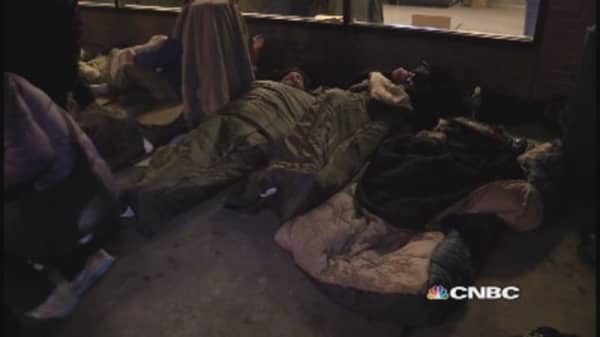On a daily basis, our society tells homeless kids they don't count. We want to fix that, and that's why we're excited about a bill introduced in the Senate last month, that would require the Department of Housing and Urban Development, the agency best positioned to help the homeless, to make it easier for homeless children and youth to be counted and to be served.
The bill, the Homeless Children and Youth Act, requires HUD to count someone as homeless if another federal agency -- such as the Department of Education -- does. The bill was introduced by Senators Dianne Feinstein (D-CA) and Rob Portman (R-OH) and Congressmen Steve Stivers (R-Ohio), Rodney Davis (R-Illinois) and Congressman Dave Loebsack (D-Iowa).
Read MoreWhy executives are sleeping on the street
Getting these figures right is critically important, especially as young lives are at stake: In October, the Federal Administration on Children, Youth and Families, released a study showing that 53 percent of homeless kids cannot find places to sleep because shelters are full.
Currently HUD's annual count of homeless people does not include homeless children and youth who are living doubled up with friends or relatives, or staying at motels.
"Children living in these situations are particularly vulnerable to predators, including traffickers, because they are hidden to social-service providers and do not have case managers," according to Sen. Feinstein's office, which estimates there are one million such uncounted children and youth. The Department of Education, for example, considers such young people homeless, and provides them with extra services.
Read MoreTiny houses: A big idea to end homelessness
A HUD spokesman noted that it is wrong to suggest that those HUD counts and those HUD serves are the same, and that if a person is at imminent risk of being homeless, he or she is just as qualified for assistance under HUD programs as they would be if they were on the street.
But it's very difficult for young people to prove that they are at risk of homelessness — they don't receive eviction notices from adults who abuse or neglect them. There's no form for a kid to sign to prove she can't stay with her parents because they reject her for being a lesbian or transgender. They don't keep careful paper trails of where they've been able to crash for the night. And it's difficult for teenagers and young adults to open up to a bureaucrat behind a desk about the traumatic circumstances that are sending them to the streets.
Shockingly, HUD ruled in January that young people who are forced into prostitution or are trading sex for someplace to stay could NOT be counted as homeless in the agency's Point in Time count, a snapshot of the number of people living in shelters or on the streets on a given night in January. If those young people, who are at grave risk of physical and psychological harm, aren't considered worth counting as in need of a safe place to stay, what kind of society have we become?
HUD also requires communities to focus on helping homeless veterans and chronically homeless people, in its efforts to eliminate those forms of homelessness by the end of 2015 and 2017, respectively. Figures from 2014 showed a 33 percent decrease in the number of homeless veterans and a 21 percent decrease in chronically homeless people, over 2010.
Advocates for homeless youth have been concerned that HUD resources are moving away from the transitional living programs young people use, to permanent supportive housing, for homeless vets and the chronically homeless. The new bill would allow local communities to set their own local priorities for serving various homeless populations.
"It's great that progress has been made, but statutory changes need to be made to remove existing barriers and help young people and families," said Darla Bardine, head of the National Network 4 Youth, a group advocating for homeless youth.
The federal government hopes to eliminate youth homelessness by 2020, but it will be difficult to do so without a complete count of homeless children and young adults.
Read MoreDriven from Silicon Valley's 'Jungle,' homeless face limited options
"How are you going to end it by 2020 if you do not acknowledge all the youth and families that are homeless?" Ms. Bardine said. "Congress is never going to appropriate the money that is needed to serve all homeless youth in America if they don't have the full picture of all homeless people who need resources."
At Covenant House, the nation's largest charity serving homeless, trafficked and vulnerable children and youth in 27 cities across the Americas, we need a realistic picture of who needs our help. In several of the cities we serve, we at times have not had enough beds for the young people arriving at our doors, and we have had to create waiting lists. The needs young people bring with them are more acute than in years past, particularly in terms of unemployment and educational deficits.
By passing the Homeless Children and Youth Act, Congress can ensure that we all can work more effectively to end youth homelessness, and protect young people from the dangers — violence, traffickers, the cold, depression, suicide — they face without a permanent home.
Commentary by Kevin Ryan, president of Covenant House International, the largest charity in the Americas serving homeless, runaway and trafficked young people. He is the co-author of "Almost Home: Helping Kids Move from Homelessness to Hope" (Turner 2012). Follow him on Twitter @CovHousePrez.




